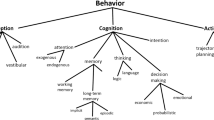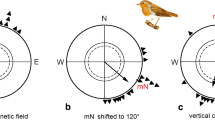Summary
This study correlates certain features of the Jamming Avoidance Response (JAR) in the electric fish,Eigenmannia, with specific properties of electroreceptors and higher-order electrosensitive units. The JAR is a shift of the animal's own electric organ discharge (EOD) frequency away from similar frequencies of foreign signals, such as EODs of conspecifics. It is controlled by characteristic modulations in the amplitude, ¦S¦, and phase,H, of the electric stimulus which result if foreign signals are superimposed upon the animal's own EOD. Modulations of ¦S¦ andH are respectively encoded in terms of the probability,p, ofP-type electroreceptor firing and in the timing,t, ofT-type electroreceptor firing (Fig. 1). In this paper we describe experiments on curarized animals whose silenced EODs were replaced by an electric stimulus,S 1, while other stimuli,S 2 and sometimes an additionalS 3, mimicked EODs of conspecific neighbors. The results are as follows:
-
1.
The complicated modulations in phase,H, and amplitude, ¦S¦, which result if two foreign stimuli interfere with the animal's EOD, are rather faithfully represented by the timing,t, ofT-unit firing and the probability,p, ofP-unit firing respectively (Fig. 2). However, larger systematic distortions are found in the representation of certain stimulus regimes (Fig. 3), and these distortions cause specific behavioral effects.
-
2.
Given an EOD fundamental frequency,f, JARs can be elicited by a sine wave stimulus with frequency near that of either the fundamental or the higher harmonic, 2f. No JARs result if the stimulus frequency is near the subharmonic,f/2 (Bullock et al. 1972). Correspondingly, the probability,p, ofP-unit firing and the timing,t, ofT-unit firing are modulated in a continuous manner only in the first two instances (f and 2f) but in a discontinuous manner in the last case (f/2). Thus only continuous modulations ofp andt appear to elicit the JAR (Figs. 4 to 6).
-
3.
The possibility of viewing the effect of a closed graph in the ¦S¦,H-state plane as the sum of the contributions made by small vectors which constitute this graph is discussed in the light of receptor responses (Figs. 7–9).
-
4.
If the intensity ratio ¦S 2¦/¦S 1¦ is constant over the animal's body surface no JAR can be elicited as long asS 1 andS 2 are pure sine waves. However, JARs will result under this condition ifS 1 is clipped in one half cycle of its sinusoidal wave from. This correlates with the fact that the modulations of the probability,p, ofP-unit firing and the modulation of the difference,t 1-t 2, in the timing of the firing of pairs ofT-units become Δf-sign specific ifS 1 is clipped. This sign specificity introduces sign-specific differences inp, t-graphs as they normally, and in much stronger form, result from local differences in the ¦S2¦/¦S1¦ ratio (Figs. 10, 11). It is therefore not necessary to postulate JAR mechanisms other than the one presented earlier (Heiligenberg et al. 1978) in order to explain the effect of clipped sine waves.
Similar content being viewed by others
References
Bastian J, Heiligenberg W (1980a) Neural correlates of the Jamming Avoidance Response inEigenmannia. J Comp Physiol 136:135–152
Bastian J, Heiligenberg W (1980b) Phase-sensitive midbrain neurons inEigenmannia: Neural correlates of the Jamming Avoidance Response. Science 209:828–831
Bullock TH, Chichibu S (1965) Further analysis of sensory coding in electroreceptors of electric fish. Proc Natl Acad Sci USA 54 (2):422–429
Bullock TH, Hamstra RH, Scheich H (1972) The Jamming Avoidance Response in high frequency electric fish. J Comp Physiol 77:1–48
Heiligenberg W (1977): Principles of electrolocation and jamming avoidance in electric fish. Studies of brain function, vol 1. Springer, Berlin Heidelberg New York, pp 1–85
Heiligenberg W (1980) The Jamming Avoidance Response in the weakly electric fishEigenmannia. Naturwissenschaften 67:499–507
Heiligenberg W, Bastian J (1980) The control of Eigenmannia's pacemaker by distributed evaluation of electroreceptive afferences. J Comp Physiol 136:113–133
Heiligenberg W, Baker C, Matsubara J (1978) The Jamming Avoidance Response inEigenmannia revisited: The structure of a neuronal democracy. J Comp Physiol 127:267–286
Hopkins CD (1976) Stimulus filtering and electroreception: Tuberous electroreceptors in three species of gymnotoid fish. J Comp Physiol 111:171–208
Maler L (1979) The posterior lateral line lobe of certain gymnotoid fish: quantitative light microscopy. J Comp Neurol 183:323–364
Maler L, Sas EKB, Rogers J (1980) The cytology of the posterior lateral line lobe of high frequency weakly electric fish (gymnotiformes): dendritic differentiation and synaptic specificity in a simple cortex. J Comp Neurol (in press)
Partridge BL, Heiligenberg W (1980) Three's a crowd? PredictingEigenmannia's responses to multiple jamming. J Comp Physiol 136:153–164
Scheich H (1977) Neural basis of communication in the high frequency electric fishEigenmannia virescens (Jamming Avoidance Response). J Comp Physiol 113:181–255
Scheich H, Bullock TH, Hamstra RH (1973) Coding properties of two classes of afferent nerve fibers: High frequency electroreceptors in the electric fish,Eigenmannia. J Neurophysiol 36: 39–60
Scheich H, Bullock TH (1974) The detection of electric fields from electric organs. In: Fessard A (ed) Handbook of sensory physiology, vol III/3. Electroreceptors and other specialized receptors in lower vertebrates. Springer, Berlin Heidelberg New York, pp 201–256
Viancour T (1979) Electroreceptors of a weakly electric fish. Characterization of tuberous receptor organ tuning. J Comp Physiol 133:317–325
Watanabe A, Takeda K (1963) The change of discharge frequency by A.C. stimulus in a weakly electric fish. J Exp Biol 40:57–66
Author information
Authors and Affiliations
Additional information
Abbreviations: see Methods
We thank Dr. John Thorson and an anonymous referee for their most helpful criticism. This work was supported by NSF grant BNS76-20761 and NIMH grant PHSMH-2614904 to W.H. and an NSF postdoctoral fellowship to B.L.P.
Rights and permissions
About this article
Cite this article
Heiligenberg, W., Partridge, B.L. How electroreceptors encode JAR-eliciting stimulus regimes: Reading trajectories in a phase-amplitude plane. J. Comp. Physiol. 142, 295–308 (1981). https://doi.org/10.1007/BF00605443
Accepted:
Issue Date:
DOI: https://doi.org/10.1007/BF00605443




